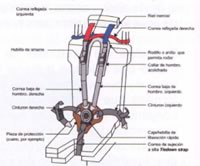Diseño preliminar de la configuración de cabina para la aeronave de entrenamiento primario phaeton PT-01
DOI:
https://doi.org/10.18667/cienciaypoderaereo.51Keywords:
ergonomics, visibility, flight controls, flight instruments, safety, preliminary designAbstract
The space in the cockpit in an aircraft directly affects the capabilities of the crew to do its jobs. Comfort, atmosphere, lighting condition and the way all information from the aircraft is shown in the instruments are some of the factors that are important in every flight situation. The methodology for the preliminary design of the cockpit and its interaction with the crew based on a design process centered on human beings will be the main topic of this article.
Downloads
References
Estrada M., Jairo y otros. Parámetros antropométricos de la población laboral colombiana 1995 (Acopla95). En: Revista Facultad Nacional de Salud Publica. Medellin. Vol. 15, No.2 (ene. - jun. 1998); p. 112-139.
Roskam, Jan. Airplane Design Part Ill: Layout design of cockpit, fuselage, wing and empennage: Cutaways and inboard profiles. Lawrence, KA: DARcorporation, 2002.454 p.
Federal Aviation administration. Advisory circular 25 .773 - 1: Pilot compartment view design considerations. S.l.: FAA, 1993. 6 p.
Federal Aviation administration. Advisory circular 25.775-1 : Windows and Windshields. S.l.: FAA, 2003. 10 p.
Federal Aviation administration human factors division. Human factors Criteria for Displays: A human factors design standard update of chapter 5. Washington, FAA, 2007. p. 5-7
General Aviation Manufacturers Association. Recommended practices and Guidelines for Part 23 Cockpit/Flight Deck Design. Washington, GAMA, 2000.103 p.
Oregon Aero®. Oregon Aero® High-G Seat. www.oregonaero.com/p48_2001 .htm

Downloads
Published
Issue
Section
License
Assignment of Copyrights
Authors assign Ciencia y Poder Aéreo journal the exclusive rights (reproduction, distribution, public communication, and transformation) to exploit and commercialize their work, in whole or in part, in all the formats and modalities of present or future exploitation, in all languages, throughout the life of the work and throughout the world.
All contents published in Ciencia y Poder Aéreo journal are licensed under a Creative Commons Attribution 4.0 International License, whose complete information is available at http://creativecommons.org/licenses/by/4.0/
Under the terms of this license, users are free to download, print, extract, archive, distribute and publicly communicate the content of articles, provided that proper credit is granted to authors and Ciencia y Poder Aéreo, scientific journal of the Graduate School of the Colombian Air Force. Except when otherwise indicated, this site and its contents are licensed under a Creative Commons Attribution 4.0 International License.
For other uses not considered under this license it is required to contact the Director or the Editor of the journal at the e-mail address cienciaypoderaereo1@gmail.com.
The Graduate School of the Colombian Air Force and this publication are not responsible for the concepts expressed in the articles, including the metadata or the affiliation stated by authors. This is the full responsibility of the authors.





















